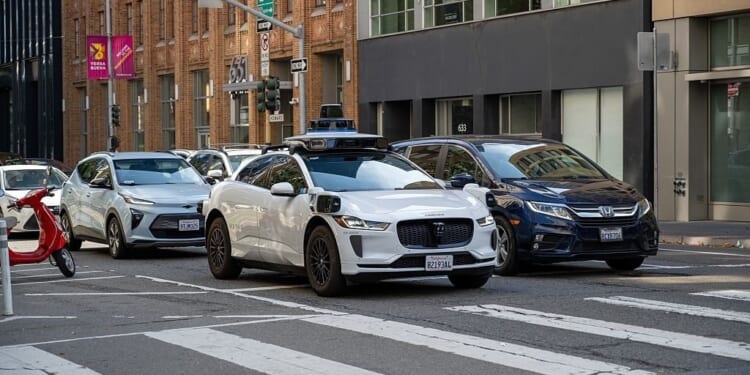General Motors took to the stage on October 22 during its “GM Forward” event, but it wasn’t there to promote another shiny electric car. The company seemed to step right out of a Jetsons cartoon, describing a world in which cars can think, talk, and even drive themselves. It sounded like science fiction mixed with Saturday morning cartoons, except, this time, it’s actually happening. Still, one big question hangs in the air: Are we really ready to take our eyes off the road?
GM Offering Eyes-Off Technology
GM focused on two things: conversation and eyes-off technology. Starting in 2026, GM plans to add Google’s Gemini artificial intelligence system to its vehicles. Instead of tapping buttons or scrolling through screens, you’ll just talk to your car. Want to find a new coffee shop, message your boss, or plan a route home? You’ll be able to ask your car out loud, and it will respond in a natural voice, almost like a human. GM says this new AI will learn your preferences over time, making it smarter the more you drive with it.
“Our vision is to create a car that knows you, that looks out for you, and just meets your needs, even before you say,” Sterling Anderson, GM chief product officer, said during the event. “Autonomy will make our roads safer. They’ll give customers back their most valuable asset: time. It’ll be a cornerstone of GM product portfolio going forward.”
David Richardson, a former Apple executive and current GM vice president of software and services engineering, expounded on that. “In the future, we will introduce our own AI fine-tuned to your vehicle. Think of this as an assistant. It’s going to anticipate your needs, offer timely help and make every journey more personable and more enjoyable.”
But that’s only the first step. By 2028, GM plans to introduce what it calls “eyes-off” driving, which is technology that would actually allow drivers to take their eyes off the road while cruising on certain mapped highways. The feature will debut in the all-electric Cadillac Escalade IQ, which is expected to cost around $127,500, in 2028.
For now, the system won’t work everywhere or all the time. It will only be available on highways that GM has already mapped in detail, which include more than 600,000 miles across North America so far. The cars will rely on multiple sensors, including cameras, radar, and lidar, to “see” everything around them. Unlike Tesla’s camera-only system, GM’s approach uses several layers of detection for extra safety. The company says the technology builds on its current Super Cruise driver-assist system, which has already logged over 700 million hands-free miles with no reported crashes caused by the system.
If it all works as planned, drivers could one day relax on long highway trips and can even enjoy reading, texting, or even taking a nap while the car does the work. But there are plenty of hurdles before that happens. Regulators will need to approve the system. Insurance companies will need to rethink how liability works when the car is technically the one driving.
The Dangers of More Artificial Intelligence
Of course, not everyone is convinced this is progress. Critics warn that as drivers rely more on automation, their attention and reaction times could dull. They point to studies showing that even when people know they’re supposed to stay alert, they often relax too much when the car takes over. That could make it harder to react in an emergency.
Research collected by the Insurance Institute for Highway Safety (IIHS) shows that drivers tend to multitask when using partial automation. In some cases, they learn how to skirt the systems’ attention requirements. “If you train them to think that paying attention means nudging the steering wheel every few seconds, then that’s exactly what they’ll do,” IIHS President David Harkey explained.
When drivers use assisted-driving tools, they tend to relax because the car seems to “take care of things.” That means less attention on their part. Even a few seconds’ delay in taking over can matter a lot when it comes to safety.

There’s also the simple human factor that driving isn’t just about getting from one place to another. For many people, it’s about control, freedom, independence, and awareness of the world around them. Giving that up – even partially – can have adverse effects.
One large review published by PubMed Central looked at 16 studies of drivers aged 55 and older who stopped driving. It found that giving up driving was “associated with declines in general health and physical, social, and cognitive function” and with greater risks of admission to long-term care or death. The review also found that older adults who stopped driving had about twice the odds of experiencing depressive symptoms compared to older adults who still drove. In another study of 6,916 US adults aged 65-plus, researchers found those who stopped driving had a two-fold increase in the odds of being more socially isolated compared to peers who still drove.
It may have looked fun in the Jetsons, and having a car that takes care of everything for you may seem like a way to relax, or maybe be more productive, but just how much of your life are you willing to give up to artificial intelligence? The old adage that if you don’t use it, you lose it, is becoming more relevant as AI becomes a larger part of our lives. Perhaps Eliezer Yudkowsky, an AI researcher and writer, has it right when he said, “By far, the greatest danger of Artificial Intelligence is that people conclude too early that they understand it.”

















